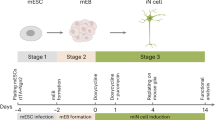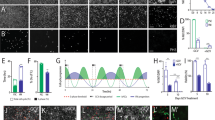Abstract
Heterokaryons are the product of cell fusion without subsequent nuclear or chromosome loss. Decades of research using Sendai-virus or polyethylene glycol (PEG)-mediated fusion in tissue culture showed that the terminally differentiated state of a cell could be altered. But whether stable non-dividing heterokaryons could occur in animals has remained unclear. Here, we show that green fluorescent protein (GFP)-positive bone-marrow-derived cells (BMDCs) contribute to adult mouse Purkinje neurons through cell fusion. The formation of heterokaryons increases in a linear manner over 1.5 years and seems to be stable. The dominant Purkinje neurons caused the BMDC nuclei within the resulting heterokaryons to enlarge, exhibit dispersed chromatin and activate a Purkinje neuron-specific transgene, L7-GFP. The observed reprogrammed heterokaryons that form in brain may provide insights into gene regulation associated with cell-fate plasticity.
This is a preview of subscription content, access via your institution
Access options
Subscribe to this journal
Receive 12 print issues and online access
$209.00 per year
only $17.42 per issue
Buy this article
- Purchase on Springer Link
- Instant access to full article PDF
Prices may be subject to local taxes which are calculated during checkout







Similar content being viewed by others
References
Darlington, G.J., Bernard, H.P. & Ruddle, F.H. Human serum albumin phenotype activation in mouse hepatoma–human leukocyte cell hybrids. Science 185, 859–862 (1974).
Ephrussi, B. & Weiss, M.C. Interspecific hybridization of somatic cells. Proc. Natl Acad. Sci. USA 53, 1040–1042 (1965).
Harris, H. Cell fusion: the Dunham lectures (Harvard University Press, Cambridge, 1970).
Peterson, J.A. & Weiss, M.C. Expression of differentiated functions in hepatoma cell hybrids: induction of mouse albumin production in rat hepatoma–mouse fibroblast hybrids. Proc. Natl Acad. Sci. USA 69, 571–575 (1972).
Ringertz, N. & Savage, R.E. Cell hybrids (Academic Press, New York, 1976).
Blau, H.M., Chiu, C.P. & Webster, C. Cytoplasmic activation of human nuclear genes in stable heterokaryons. Cell 32, 1171–1180 (1983).
Spear, B.T. & Tilghman, S.M. Role of α-fetoprotein regulatory elements in transcriptional activation in transient heterokaryons. Mol. Cell Biol. 10, 5047–5054 (1990).
Wright, W.E. Induction of muscle genes in neural cells. J. Cell Biol. 98, 427–435 (1984).
Wright, W.E. Expression of differentiated functions in heterokaryons between skeletal myocytes, adrenal cells, fibroblasts and glial cells. Exp. Cell Res. 151, 55–69 (1984).
Blau, H.M. & Baltimore, D. Differentiation requires continuous regulation. J. Cell Biol. 112, 781–783 (1991).
Blau, H.M., Brazelton, T.R. & Weimann, J.M. The evolving concept of a stem cell: entity or function? Cell 105, 829–841 (2001).
Frisen, J. Stem cell plasticity? Neuron 35, 415–418 (2002).
LaBarge, M.A. & Blau, H.M. Biological progression from adult bone marrow to mononucleate muscle stem cell to multinucleate muscle fiber in response to injury. Cell 111, 589–601 (2002).
Lagasse, E. et al. Purified hematopoietic stem cells can differentiate into hepatocytes in vivo. Nature Med. 6, 1229–1234 (2000).
Krause, D.S. et al. Multi-organ, multi-lineage engraftment by a single bone marrow-derived stem cell. Cell 105, 369–377 (2001).
Mezey, E., Chandross, K.J., Harta, G., Maki, R.A. & McKercher, S.R. Turning blood into brain: cells bearing neuronal antigens generated in vivo from bone marrow. Science 290, 1779–1782 (2000).
Priller, J. et al. Neogenesis of cerebellar Purkinje neurons from gene-marked bone marrow cells in vivo. J. Cell Biol. 155, 733–738 (2001).
Terada, N. et al. Bone marrow cells adopt the phenotype of other cells by spontaneous cell fusion. Nature 416, 542–545 (2002).
Vassilopoulos, G., Wang, P.R. & Russell, D.W. Transplanted bone marrow regenerates liver by cell fusion. Nature 422, 901–904 (2003).
Wang, X. et al. Cell fusion is the principal source of bone-marrow-derived hepatocytes. Nature 422, 897–901 (2003).
Manuelidis, L. & Manuelidis, E.E. On the DNA content of cerebellar Purkinje cells in vivo and in vitro. Exp. Neurol. 43, 192–206 (1974).
Mares, V., Lodin, Z. & Sacha, J. A cytochemical and autoradiographic study of nuclear DNA in mouse Purkinje cells. Brain Res. 53, 273–289 (1973).
Mann, D.M., Yates, P.O. & Barton, C.M. The DNA content of Purkinje cells in mammals. J. Comp. Neurol. 180, 345–347 (1978).
Armengol, J.A. & Sotelo, C. Early dendritic development of Purkinje cells in the rat cerebellum. A light and electron microscopic study using axonal tracing in 'in vitro' slices. Brain Res. Dev. Brain Res. 64, 95–114 (1991).
Hatten, M.E., Alder, J., Zimmerman, K. & Heintz, N. Genes involved in cerebellar cell specification and differentiation. Curr. Opin. Neurobiol. 7, 40–47 (1997).
Fernandez-Gonzalez, A. et al. Purkinje cell degeneration (pcd) phenotypes caused by mutations in the axotomy-induced gene, Nna1. Science 295, 1904–1946 (2002).
Graham, D.I. & Lantos, P.L. Greenfields Neuropathology (Oxford University Press, New York, 1997).
Weimann, J.M., Charlton, C.A., Brazelton, T.R., Hackman, R.C. & Blau, H.M. Contribution of transplanted bone marrow cells to Purkinje neurons in human adult brains. Proc. Natl Acad. Sci. USA 100, 2088–2093 (2003).
Baron, M.H. & Maniatis, T. Rapid reprogramming of globin gene expression in transient heterokaryons. Cell 46, 591–602 (1986).
Blau, H.M. et al. Plasticity of the differentiated state. Science 230, 758–766 (1985).
Blau, H.M. Differentiation requires continuous active control. Annu. Rev. Biochem. 61, 1213–1230 (1992).
Tomomura, M., Rice, D.S., Morgan, J.I. & Yuzaki, M. Purification of Purkinje cells by fluorescence-activated cell sorting from transgenic mice that express green fluorescent protein. Eur. J. Neurosci. 14, 57–63 (2001).
Eglitis, M.A. & Mezey, E. Hematopoietic cells differentiate into both microglia and macroglia in the brains of adult mice. Proc. Natl Acad. Sci. USA 94, 4080–4085 (1997).
Ferrari, G. et al. Muscle regeneration by bone marrow-derived myogenic progenitors. Science 279, 1528–1530 (1998).
Rubin, P., Gash, D.M., Hansen, J.T., Nelson, D.F. & Williams, J.P. Disruption of the blood–brain barrier as the primary effect of CNS irradiation. Radiother. Oncol. 31, 51–60 (1994).
Lapham, L.W. Tetraploid DNA content of Purkinje neurons of human cerebellar cortex. Science 159, 310–312 (1968).
Bohm, N. & Noltemeyer, N. Development of binuclearity and DNA polyploidization in the growing mouse liver. Histochemistry 72, 55–61 (1981).
Epstein, C.J. & Gatens, E.A. Nuclear ploidy in mammalian parenchymal liver cells. Nature 214, 1050–1051 (1967).
Michalopoulos, G.K. & DeFrances, M.C. Liver regeneration. Science 276, 60–66 (1997).
Harris, H., Watkins, J.F., Campbell, G.L., Evans, E.P. & Ford, C.E. Mitosis in hybrid cells derived from mouse and man. Nature 207, 606–608 (1965).
Davidson, R.L. & de la Cruz, F. Somatic Cell Hybridization (Ravin Press, New York, 1974).
Okabe, M., Ikawa, M., Kominami, K., Nakanishi, T. & Nishimune, Y. 'Green mice' as a source of ubiquitous green cells. FEBS Lett. 407, 313–319 (1997).
Rehen, S.K. et al. Chromosomal variation in neurons of the developing and adult mammalian nervous system. Proc. Natl Acad. Sci. USA 98, 13361–13366 (2001).
Acknowledgements
We thank K. Koleckar for her excellent technical support and R. Doyonnas, M. LaBarge, A. Okada, F. Rossi and M. Springer for useful comments. We also thank M. Yuzaki for the generous gift of the L7-pcp-2 transgenic mice. This work was supported by a fellowship from the Wenner-Gren Foundation, Sweden, to C.B.J. and a National Institutes of Health grant AG20961 to J.M.W. and H.M.B. and NIH grants AG09521, HL65572, HD18179, Ellison Medical Foundation grant AG-33-0817, the McKnight Endowment Fund and the Baxter Foundation to H.M.B.
Author information
Authors and Affiliations
Corresponding authors
Ethics declarations
Competing interests
The authors declare no competing financial interests.
Rights and permissions
About this article
Cite this article
Weimann, J., Johansson, C., Trejo, A. et al. Stable reprogrammed heterokaryons form spontaneously in Purkinje neurons after bone marrow transplant. Nat Cell Biol 5, 959–966 (2003). https://doi.org/10.1038/ncb1053
Received:
Accepted:
Published:
Issue Date:
DOI: https://doi.org/10.1038/ncb1053
This article is cited by
-
Binucleated human bone marrow-derived mesenchymal cells can be formed during neural-like differentiation with independence of any cell fusion events
Scientific Reports (2022)
-
Immune-tolerance to human iPS-derived neural progenitors xenografted into the immature cerebellum is overridden by species-specific differences in differentiation timing
Scientific Reports (2021)
-
Donor Recipient Chimeric Cells Induce Chimerism and Extend Survival of Vascularized Composite Allografts
Archivum Immunologiae et Therapiae Experimentalis (2021)
-
Genome remodeling upon mesenchymal tumor cell fusion contributes to tumor progression and metastatic spread
Oncogene (2020)
-
Polyploidy in liver development, homeostasis and disease
Nature Reviews Gastroenterology & Hepatology (2020)



